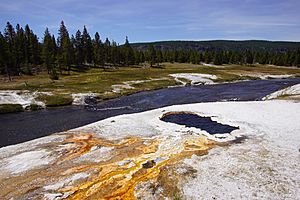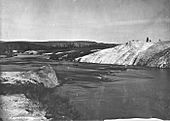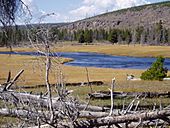Firehole River facts for kids
Quick facts for kids Firehole River |
|
|---|---|

Firehole River
|
|
|
Firehole River near South Scalloped Spring
|
|
| Country | United States |
| State | Wyoming |
| Physical characteristics | |
| Main source | Madison Lake Yellowstone National Park, Wyoming 44°20′37″N 110°52′43″W / 44.34361°N 110.87861°W |
| River mouth | Madison River Madison Junction, Wyoming 44°38′32″N 110°51′56″W / 44.64222°N 110.86556°W |
| Length | 21 mi (34 km) |
| Basin features | |
| Tributaries |
|
The Firehole River is a cool river in northwestern Wyoming. It's one of the two main streams that form the Madison River. The Firehole River flows about 21 miles (34 km) (that's about 34 kilometers) from where it starts at Madison Lake. This lake is right on the Continental Divide. The river then joins the Gibbon River at Madison Junction, all inside Yellowstone National Park. It's also part of the bigger Missouri River system.
Contents
Exploring the Firehole River
The Firehole River flows right through some amazing geyser areas in Yellowstone National Park. These include the Upper Geyser Basin, where you can find the world-famous geyser Old Faithful. Early explorers named the river "Firehole" because of the steam rising from it. This steam made it look like the river was smoking or on fire!
The Firehole River also has three major waterfalls in Yellowstone. These are Kepler Cascades (south of Old Faithful), Firehole Falls, and the Cascades of the Firehole (in Firehole Canyon).
Hot Water and Unique Life
The river gets water from many geothermal spots, like hot springs and geysers. This makes the river water warmer than usual. Temperatures in the river can reach as high as 30 °C (86 °F). That's about 86 degrees Fahrenheit! On average, the water is 5 to 10 °C (9 to 18 °F) warmer than areas without these hot water inputs.
The hot water also brings dissolved chemicals and minerals into the river. Even with these, amazing fish like brown and rainbow trout live and lay their eggs in the Firehole River. However, an unwanted guest, the New Zealand mud snail (Potamopyrgus antipodarum), has also been found here.
River Branches and Cool Spots
Important smaller streams flow into the Firehole River. These are the Little Firehole River, Fairy Creek, Iron Spring Creek, Sentinel Creek, and Nez Perce Creek. All these smaller streams bring cool water to the Firehole. This cool water is very important for the trout, giving them places to escape when the main river gets too warm from the geothermal activity in the middle of summer.
Fishing in the Firehole River
The Firehole River is a very popular place for people who love to fly fish. When explorers first found the Firehole in the 1830s, there were no trout living above Firehole Falls.
Trout and Fishing Rules
Brook trout were first brought to the upper Firehole in 1889. Then, brown trout, which are the most common trout in the river today, were added in 1890. Rainbow trout came much later, in 1923. Another fish, the Mountain whitefish, naturally lives in the Firehole below Firehole Falls.
By the late 1800s, Yellowstone National Park, including the Firehole River, was a favorite spot for fishermen. In 1955, all programs that added fish to the park's rivers were stopped. This means that today, all the trout in the Firehole River are wild. In 1968, because so many people were fishing, the National Park Service made a rule. They said that fishing in the Firehole, Gibbon, and Madison rivers could only be done by fly fishing.
Gallery








